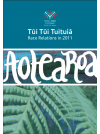The year 2011 was dominated by the Canterbury earthquakes, the hosting of the Rugby World Cup, the environmental consequences of the foundering of the container ship Rena in the Bay of Plenty, and the General Election. Each of these major events had their particular race relations dimension.
The Canterbury earthquake in February demonstrated the common humanity of New Zealanders of all ethnicities reaching out to help each other, but also emphasised the need for public authorities to ensure that culturally and linguistically diverse communities are properly catered for in the response to civil emergencies.
New Zealanders again came together to welcome international teams and visitors to the Rugby World Cup, showcasing and celebrating our diverse cultures and in particular our strong Māori, Pacific and European traditions.
The grounding of the Rena on the Astrolabe Reef in the Bay of Plenty was a major environmental disaster. Māori had to actively assert their role as tangata whenua and kaitiaki in the immediate and longer term response to the damaged marine and coastal environment.
The General Election resulted in the return of a National led Government, with support from the Māori, United Future and ACT Parties. The confidence and supply agreement reached with the Māori Party is focused on a number of key race relations issues, including, in particular, the economic and social disadvantage experienced by Māori. Also significant was the outcome of the referendum on the Mixed Member Proportional (MMP) representation system for parliamentary elections – a clear majority favouring its retention. MMP has been responsible for a much more diverse Parliament since its introduction in 1996. Just over a quarter of all MPs in the new Parliament identify as Mäori, Pacific or Asian, similar to the proportions in the previous Parliament. The number of Māori MPs remained the same at 21, the number of Pacific MPs increased from five to six, and the number of Asian MPs reduced from six to five. The new Cabinet has four Māori Ministers, including two on the front bench. Cabinet was sworn in in December by the new Governor General, Lt General Jerry Mateparae, who is also Mäori.
Each chapter of this year’s report includes a brief look back over the past five years in order to inform the United Nations Committee on the Elimination of Racial Discrimination in conducting their five yearly review of race relations in New Zealand. Some of the features of that period have been:
• the growth of the New Zealand Diversity Action Programme, with around 250 organisations each year delivering a total of more than 3200 diversity projects
• the introduction of a new curriculum for schools emphasising the importance of the Treaty of Waitangi, cultural diversity and human rights
• the transition to a new “super-city” in Auckland with new structures and programmes to include its diverse communities
• the continuing experience by Asian New Zealanders of a higher level of discrimination and harassment than other groups
• significant progress in the hearing and settlement of claims by Māori of historical breaches of the Treaty of Waitangi by the Crown
• the persistence of disadvantage experienced by Māori and Pacific peoples in terms of social and economic rights
• an improved framework for immigration and settlement, and a more inclusive and strategic approach to refugee resettlement
• greater recognition of Māori language in the public and commercial spheres, the growth of Māori Television, and the development of a Pacific languages framework
• a wider appreciation of and respect for the increasing religious diversity of New Zealanders.

